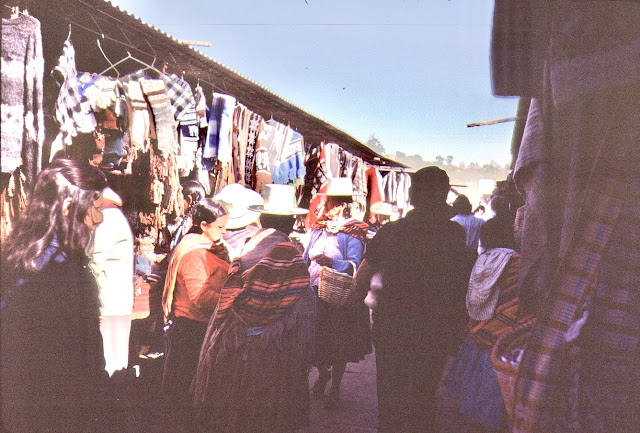La Paz, Bolivia June 15-18, 1979
Of course the bus didn’t leave Copacabana at 6, as scheduled – no surprise there – but we were on our way by 8, which was better than we might have hoped for. The ride to La Paz took us through a beautiful but bleak landscape – more altiplano grass lands, highlighted by lake and distant, but ever-approaching mountain peaks topped with dazzlingly white snow. La Paz is a big city, by south American standards, about the size of Vancouver. It’s fairly modern, and appears quite wealthy, especially in comparison with the cities in Peru. But it feels quite a lot like a Guatemala City kind of place – nothing much to recommend it, a disappointing dearth of places to eat (like Guat City). The food is also disappointing; nowhere near as good as in Peru. But the artesania items on sale – alpaca, mantas, silver and leather – look good; better quality than in Peru, although at somewhat higher prices.
Unfortunately I am freezing in my little hotel-room bed, my hands and nose like icicles, feet like frozen blocks of ice. It is COLD here, undoubtedly mostly due to the altitude, and the season: it is winter… .
Although I’ve heard much about the repressive military dictatorship here, and the country is gearing up for an election(?) on July 1st, I have seen almost no evidence of police or military types on the streets. This seems a little surprising, as there were many men with machine guns on the streets and street corners of Peru and Ecuador. I am advised that there are many plain clothes agents, but the people speak openly about their political beliefs, and many seem to think that there will be a communist victory. There are also a number of strikes going on, and demonstrations, which seem not to be drawing much in the way of government opposition or action.
The people here seem more westernized than in Peru or Ecuador. Their dress, their mannerisms, their casual-ness, is so… American. Young American, but American. From the cut of their jeans to their platform shoes, to their casual t-shirts and pull-overs, to their way of standing around on street corners, sauntering, and expressing themselves in a much more spontaneous, freer, and more animated way than the Latinos of Peru and Ecuador.
And there are numerous indicators of considerable personal wealth – very well-dressed people on the streets, newer cars, including Mercedes and BMWs, and swanky restaurants with top-notch sound systems, almost unheard of in Peru or Ecuador. It may be that the wealthy are congregated here in the city, and I will see more poverty once I travel out into the country where the majority of the indigenous campesinos live.
Bolivia has a much higher percentage of indigenous people (70% or more) than any other country in South America. It has not experienced the same degree of migration by rural campesinos, all of whom are either ‘Indios’ (the term used for indigenous people here) or ‘mestizos’ (mixed indigenous and Spanish, or Latino people), into its cities as have Ecuador and Peru. So I have yet to see a lot of indigenous people yet, and I’m aware that there are many different indigenous groups here, all of whom wear different traditional garb, and speak a variety of dialects.
The indigenous people I have seen here in La Paz are somewhat different in their facial features than their Ecuadorian or Peruvian counterparts. They are finer featured, almost oriental in appearance, with beautiful dark eyes, which always seem to be smiling. They are also much more colourful in their dress. The indigenous women here wear bright pink or red shawls and day-glo green or blue or red skirts. Over top they wear their colourful mantas or shawls, often slung over their shoulders and onto their backs, loaded with fruit, vegs, firewood and/or their youngest children. And then there’s their various hats. Here in La Paz the hats are almost exactly like a British bowler hat, except that they are a rich coffee brown with a golden tan brim and matching ribbon round the crown. It’s really quite a sight sometimes to see mama in full regalia with baby on her back, also fully decked out, including a baby bowler hat.








Comments
Post a Comment